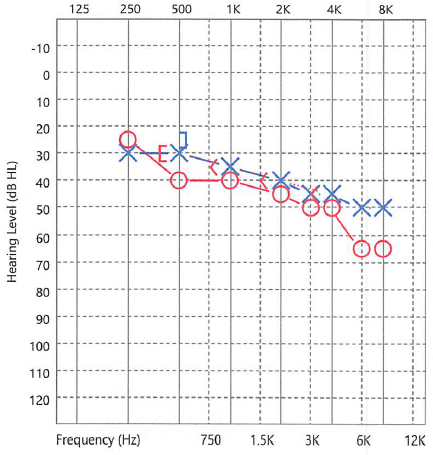Hearing is such a personal thing. Many individuals have acknowledged their hearing loss, worked with a professional to determine the extent of their unique situation, and perhaps taken the steps to find the solution that works best for them. Because of their hearing test and resulting audiogram, they have a keen understanding of the extent of their loss. It might be mild, moderate, moderately severe, severe, or profound.
These are the words that are used to describe a person’s hearing loss. They are not as specific as saying you have 20/20 vision, blood pressure above 120/80, a cholesterol level under or over 180, or regrettably, stage 1, 2, 3 or 4 cancer. When we hear those numbers, we connect to an appropriate action and most likely a health care provider. But an audiogram like the one below may not be as easily understood by the average person.
 I’m sharing the audiogram to the right and corresponding story with the permission of my good friend Bob. His primary physician recommended a visit to an ENT after Bob complained of a lasting issue with his ear following a bout with bronchitis. The ENT found no underlying issues and had some simple recommendations including having a hearing test with an audiologist. Bob followed that advice even though he felt that his hearing was fine. To his surprise, he discovered that indeed he did have hearing loss. I know Bob very well and wonder what sounds he is missing given his hearing loss at high frequencies. He is over 75, which puts him in the age group where nearly half of the population has hearing loss.1 In his words, he hears well enough. But does he?
I’m sharing the audiogram to the right and corresponding story with the permission of my good friend Bob. His primary physician recommended a visit to an ENT after Bob complained of a lasting issue with his ear following a bout with bronchitis. The ENT found no underlying issues and had some simple recommendations including having a hearing test with an audiologist. Bob followed that advice even though he felt that his hearing was fine. To his surprise, he discovered that indeed he did have hearing loss. I know Bob very well and wonder what sounds he is missing given his hearing loss at high frequencies. He is over 75, which puts him in the age group where nearly half of the population has hearing loss.1 In his words, he hears well enough. But does he?
I’d like to see him try a hearing device, either prescription or the soon to be available devices under the upcoming Over-the-Counter regulation. He is, in the words of one of my audiologist friends, “a perfect candidate for a hearing device”. If he tries a hearing aid, will he discover sounds that disappeared without him noticing? Will the convenience of streaming from his cell phone for music, video or phone calls be so convenient that it convinces him to give it a go? For Bob, like many, cost is a factor and I’ve educated him on the technology available today at various price points, some lower than $1,000. That is still an investment but the cost of a device over the expected life cycle of 4 to 5 years could make this an investment of less than $1 a day.
 We don’t know exactly how many persons in the United States have untreated hearing loss. The Center for Disease Control and the National Institute of Health estimate that between 38 to 48 million persons have a hearing loss. Hearing loss can occur as a result of aging, genetics, noise exposure or medical treatment. Left untreated, hearing loss is linked to greater risks of isolation, depression, and cognitive decline.2 No matter the cause, the best recommendation I can offer is to have your hearing checked by a hearing care professional on a regular basis, more frequently if you are older or exposed to high level of noise. And yes, if you are wondering, that includes earbuds worn consistently. If you discover that you have a hearing loss following a hearing test, understand your treatment options and if your purchase a hearing device, be sure to get a receipt, understand the return policy and any applicable warranty.
We don’t know exactly how many persons in the United States have untreated hearing loss. The Center for Disease Control and the National Institute of Health estimate that between 38 to 48 million persons have a hearing loss. Hearing loss can occur as a result of aging, genetics, noise exposure or medical treatment. Left untreated, hearing loss is linked to greater risks of isolation, depression, and cognitive decline.2 No matter the cause, the best recommendation I can offer is to have your hearing checked by a hearing care professional on a regular basis, more frequently if you are older or exposed to high level of noise. And yes, if you are wondering, that includes earbuds worn consistently. If you discover that you have a hearing loss following a hearing test, understand your treatment options and if your purchase a hearing device, be sure to get a receipt, understand the return policy and any applicable warranty.
Hear well. Stay vital. Learn more and find a professional near you at www.hearing.org